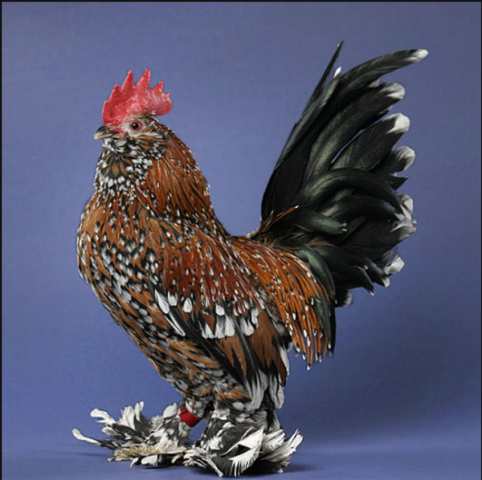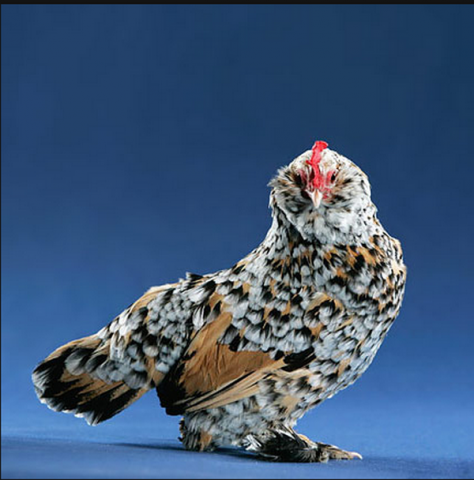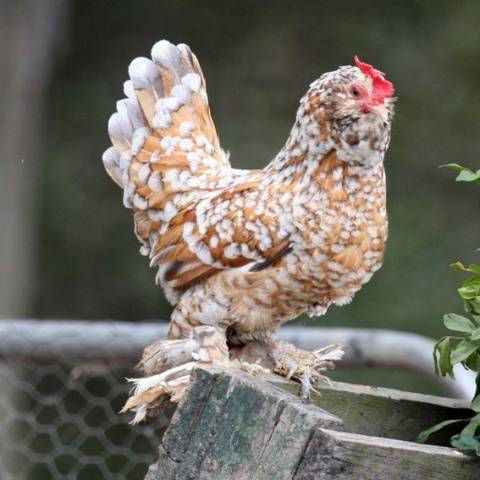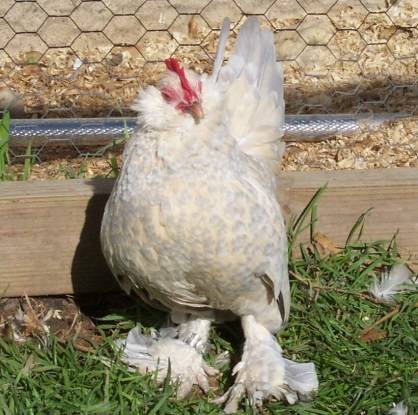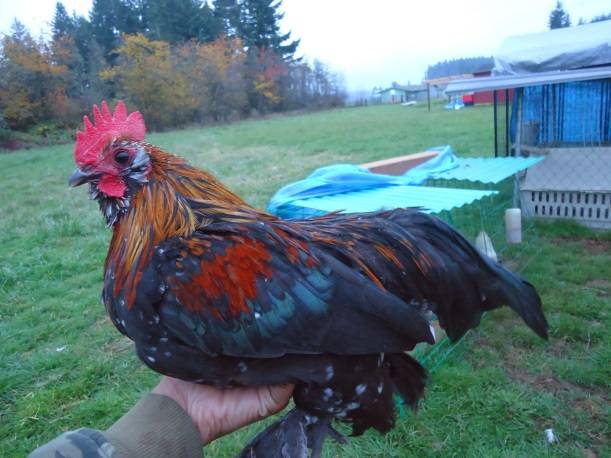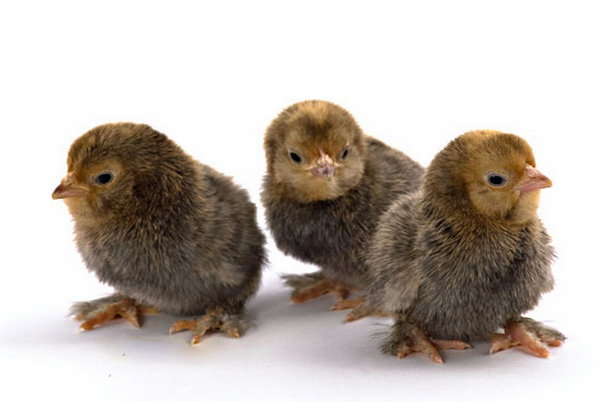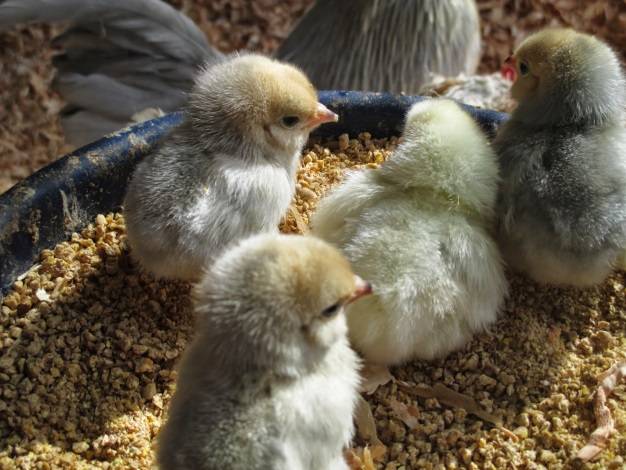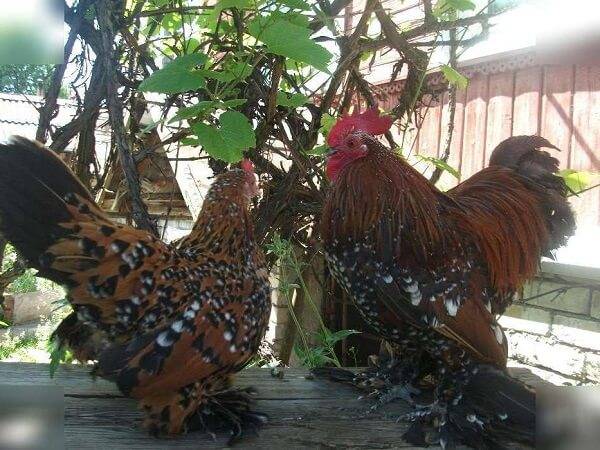Content
Milfler is a breed of chickens that does not have a large prototype. Such small decorative chickens, which were not bred from a large breed, are called real bantams... The name Milfleur translated from French means "a thousand flowers" and indicates the diversity of plumage of these little chickens. In fact, we are not talking about a thousand colors. Although Milfler chickens look multicolored, in fact, there are no more than 4 different colors in the plumage.
In the United States, this breed is known as the Belgian bearded d'Uccle. The name is due to the fact that chickens of this breed have small beards.
The history of the breed is unknown. There is only evidence that this chicken existed in Holland already in the 16th century. It is also unknown what breeds were involved in its breeding. Therefore, it is possible that the data on the absence of a large prototype simply did not survive to this day.
Description
Milfleur's weight is slightly more than 0.5 kg. An adult laying hen weighs only 600 g, a rooster - a little more than 700 g. Milflerov has a leaf-shaped comb of red color. The face, lobes and earrings are also red. The neck is long and erect. In chickens, the body in projection is closer to a spherical shape. In roosters, the body in projection is an elongated oval with a slight slope from top to bottom in the direction from the front to the back.
The tail of hens is fan-shaped, set vertically. In roosters, the tuft is denser and more inclined than in chickens. The braids are not long, but cover the tail feathers. The main color of the braids is black, but the tips are necessarily white.
The wings are large enough for this breed. Loosely pressed against the body and slightly lowered.
The hocks are very densely plumage, which makes it impossible to see the color of the skin. Feathers grow especially densely in roosters.
Colors
The beautiful coloration is the main reason hobbyists wear these bantams. In the Russian-language descriptions of Milfler chickens, more than 20 color variations are indicated. But not even all are listed. And many are wrongly named. The color options are:
- chintz;
- Colombian;
- blue (lavender?);
- black and silver;
- red & black;
- the black;
- others.
According to foreign descriptions and photos of Milfler chickens, another requirement can be traced. Of all these colors, only chintz and lavender meet foreign requirements. But usually the standards for chickens in different countries are very different from each other. Therefore, if in the United States only two colors are recognized, then in other countries there may be more color variations.
The main color is dark brown. Description and photo of this color in Milfler chickens below:
- base plumage is dark brown;
- each feather has a black crescent;
- the tips of the feathers are white.
The Milfler rooster in the photo has just this type of plumage.
There can be very little brown and black, but a lot of white. Then the chickens of the Milfler breed look like in the photo below.
You can also find lavender colors. In this case, the black color of the plumage will be "replaced" with blue. This is what the lavender color looks like in the photo of Milfler chickens:
There are options with not only two colors, but also the third - brown. Lavender color - "young". Milfleurs of this color were bred as part of the experiment by crossing individuals of the standard dark brown color with representatives of other breeds carrying the lavender gene.
Also lavender, but based on the classic dark brown plumage. In the Russian-language description of the colors of Milfler chickens, Colombian with a high degree of probability meant this type of plumage.
But the name "Colombian" is not suitable here, as there are dark spots on the body of the chickens, which are unacceptable in the Colombian color.
Porcellan color of Milfler chickens (photo).
In this breed, if desired, you can find many more colors. Strict requirements are imposed only on show lines. Lovers who have multi-colored bantams often take them for the sake of experimenting with colors, which means how Milfleur can sell a cross between two breeds of bantams. This is neither bad nor good. Suddenly someone will be able to breed a new breed of decorative chickens.
Character
The Milfler breed is distinguished by a calm temperament. Bentams do not create problems for relatives when kept together. At the same time, the quips are good mothers and, in case of need, are able to stand up for their offspring.
Milfleurs are easy to tame. Judging by the reviews of foreign owners, they often even prefer to sleep on a pillow with the owner.
Eggs
The number of eggs that these bantams can lay is not so small. For a year they lay 110 eggs weighing 30 g. In fact, few of the amateurs are interested in the productivity of ornamental hens. In any case, due to the small area of the body, the hen will not be able to hatch all the eggs she has laid.
If you want to get offspring from Milfleurs, you will have to remove the eggs and hatch the chickens in an incubator.
Chickens Milfler "classic" color hatch brown.
Nuances of growing young animals
Breeding chicks in an incubator is the same as any other chicken. But when feeding chicks, it must be borne in mind that their size is much smaller than that of ordinary large forms. In fact, these will be chicks a little larger than quail.
At the beginning of feeding, you can give the chickens compound feed for the quail. This is what is usually given abroad. But in Russia it is often impossible to get the right brand of quality feed. Therefore, they begin to feed chickens using the same "traditional" method as large forms of chickens would be fed.
The only difference is in the size of the feed particles. The egg should be chopped smaller than for large chickens. You do not need to give very coarse cereals. It is best to boil millet.
Due to their small body size, chickens need high ambient temperatures for a long time. Until the babies are fully fledged, the air temperature in the brooder is maintained at 28-31 ° C.
If a clump of dried droppings forms on the chick's toes during growth, the chick may lose a toe.
Content
When arranging a dwelling for this breed of chickens, two of their features must be taken into account:
- overgrown with feathers metatarsals and fingers;
- well developed wings.
With dense plumage on the paws, chickens need a perfectly clean bedding. While other chicken breeds can be kept on a permanent deep bed in winter, the Milfleurs need to change their "bed" frequently.
It is also necessary to equip them with a well-drained walk, on which water and dirt will not accumulate. Droppings and pieces of clay sticking to the feathers will quickly turn the feet of the bantams into hard lumps of dirt. Therefore, the walk should be covered with washed sand, and in the chicken coop, a complete change of litter should be carried out at least once a week.
Otherwise, decorative chickens are no different from their large relatives. Milfleurs are not afraid of cold weather, so they do not need an insulated chicken coop. It is enough to equip perches and a reliable shelter from the weather.
When equipping a walk, it must be borne in mind that these babies fly well. And a small body weight only contributes to flying. The walk will have to be fenced off with a fence of such a height that the bentams cannot overcome. Or make a roof in the aviary.
Feeding
If you believe the description and reviews of the Milfler breed of chickens, they do not require any delights in feed.In summer, chickens make do with green forage, a small amount of grain and caught insects. In winter, root crops are included in the diet, the rate of grain or compound feed is increased. To provide chickens with animal protein, birds are given cottage cheese, meat and bone meal, fish, eggs.
Testimonials
Conclusion
Chickens of the Milfler breed are not of serious economic importance and are used to decorate the yard. Their friendliness and affection are well suited to those poultry farmers who want to keep chickens for the soul, and not for the sake of products.

